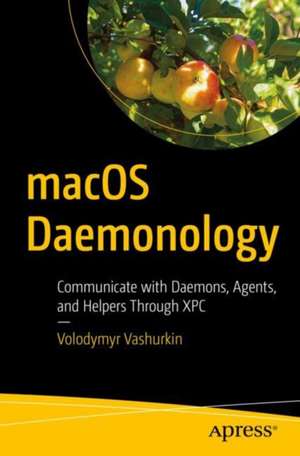macOS Daemonology: Communicate with Daemons, Agents, and Helpers Through XPC
Autor Volodymyr Vashurkinen Limba Engleză Paperback – 8 oct 2021
First, you'll take a tour around different types of daemons: user agents, privileged helpers, login items, XPC services, and System Extensions. Knowing key specifics of the daemons will open a wide range of possibilities from non-trivial application development to system development. You'll find lots of examples, working code samples, and even ready-to-use utilities. The book will guide you step-by-step through preparation, registration, and management of all kinds of daemons.
System Extensions are brand new for macOS and open additional powerful features for developers. You'll explore installation, user flow, and communication with System Extensions, too, with examples, of course. XPC provides an object-oriented way of communication. There’s no need for custom byte/text-based protocols. A good macOS developer has to know not only programming interfaces, but also design patterns related to technology. XPC communication has a few patterns of its own, and we'll go through them all, including uni- and bi-directional communication, passing objects by-value and by-proxy, handling connection invalidation, named and anonymous connections, and many more.
What You'll Learn
- Use multiples types of daemons in your applications
- Deal with System Extensions – the new type of system daemons
- Get acquainted with Swift bridging patterns for XPC communication
Who This Book Is For
Software developers and solution architects with at least a working knowledge of macOS and Swift programming. As overview, may be interested for software/solution architects.
Preț: 207.04 lei
Preț vechi: 258.80 lei
-20% Nou
Puncte Express: 311
Preț estimativ în valută:
39.62€ • 43.02$ • 33.28£
39.62€ • 43.02$ • 33.28£
Carte disponibilă
Livrare economică 01-15 aprilie
Preluare comenzi: 021 569.72.76
Specificații
ISBN-13: 9781484272763
ISBN-10: 1484272765
Pagini: 235
Ilustrații: XIII, 154 p. 34 illus.
Dimensiuni: 155 x 235 mm
Greutate: 0.23 kg
Ediția:1st ed.
Editura: Apress
Colecția Apress
Locul publicării:Berkeley, CA, United States
ISBN-10: 1484272765
Pagini: 235
Ilustrații: XIII, 154 p. 34 illus.
Dimensiuni: 155 x 235 mm
Greutate: 0.23 kg
Ediția:1st ed.
Editura: Apress
Colecția Apress
Locul publicării:Berkeley, CA, United States
Cuprins
Part 1. Daemons in the Wild.- Chapter 1. Operating System Background World.- Chapter 2. Daemon Anatomy.- Chapter 3. Daemon Management.- Part 2. Daemons in Detail.- Chapter 4. Daemons at a Glance.- Chapter 5. Classic Daemons.- Chapter 6. Privileded Helper.- Chapter 7. System Extension (since macOS 10.15).- Chapter 8. User Agent.- Chapter 9. XPC Service.- Chapter 10. Login Item.- Part 3. Talking to your Daemons.- Chapter 11. XPC at a Glance.- Chapter 12. Pass objects by-copy over XPC. NSSecureCoding.- Chapter 13. Pass object by proxy: the callable XPC objects.- Chapter 14. NSXPCListenerEndpoint - XPC service sharing
.
.
Notă biografică
Volodymyr Vashurkin (@alkenso) is an experienced macOS system and security developer and engineer. His first steps in daemonology were made while researching FileVault full disk encryption on macOS, and its interaction with iCloud services. iCloud on macOS uses plenty of system daemons and user agents, and investigating macOS’s infrastructure led to a solid understanding of how the background world of macOS works. This led him deeply into the development of security solutions for macOS. Working in the security area, Volodymyr gained practical skills for creating GUI-based applications with fewer user agents (user background processes) and root daemons (root'ed background processes). In developing his knowledge and skills, Volodymyr faced numerous tricky cases, lack of documentation, and minor and major documentation gaffes. He would like to help his readers avoid the same pitfalls.
Textul de pe ultima copertă
Take advantage of the full power of Swift through XPC. Development for macOS differs from iOS and web-based development because of multicomponent applications. Besides the usual GUI-based applications and app extensions, there are a wide range of daemons—processes that run in the background—to worry about. These include system monitoring, event listening, notification agents, and many-many more.
First, you'll take a tour around different types of daemons: user agents, privileged helpers, login items, XPC services, and System Extensions. Knowing key specifics of the daemons will open a wide range of possibilities from non-trivial application development to system development. You'll find lots of examples, working code samples, and even ready-to-use utilities. The book will guide you step-by-step through preparation, registration, and management of all kinds of daemons.
System Extensions are brand new for macOS and open additional powerful features for developers. You'll explore installation, user flow, and communication with System Extensions, too, with examples, of course. XPC provides an object-oriented way of communication. There’s no need for custom byte/text-based protocols. A good macOS developer has to know not only programming interfaces, but also design patterns related to technology. XPC communication has a few patterns of its own, and we'll go through them all, including uni- and bi-directional communication, passing objects by-value and by-proxy, handling connection invalidation, named and anonymous connections, and many more.
You will:
- Use multiples types of daemons in your applications
- Deal with System Extensions – the new type of system daemons
- Get acquainted with Swift bridging patterns for XPC communication
Caracteristici
Understand macOS daemons—the world beyond shiny GUI apps Use the flexibility and power of dameons and agents to build multicomponent applications Dive into approaches and techniques of communication across processes using XPC connection
